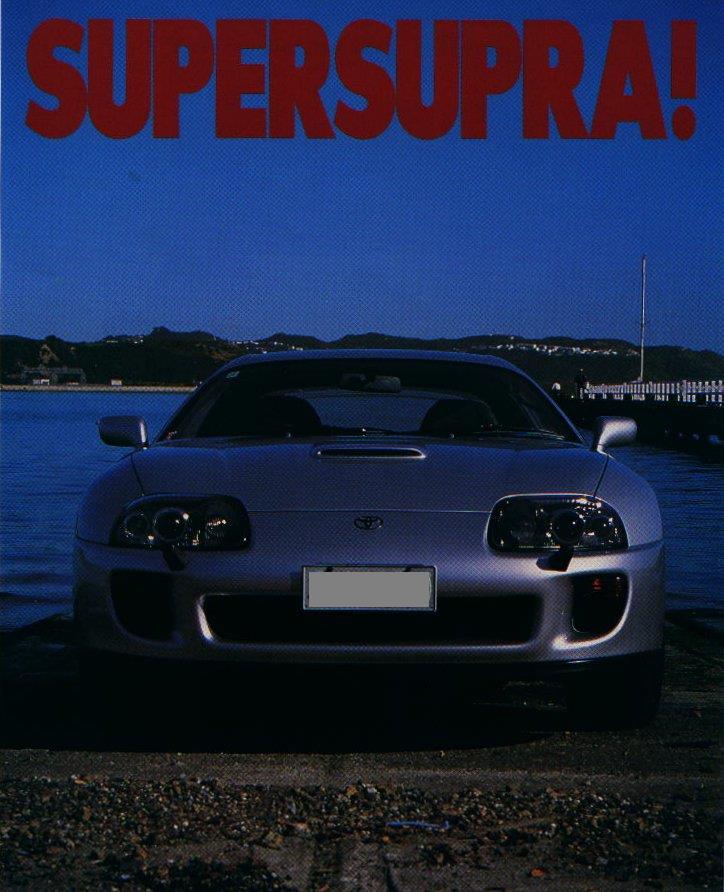
| Auto News - First Drive - March 1994 |
|---|
| Super Supra! |
The last time we road tested a Supra was four years ago. That was in the twilight months of the old car and our road test coincided with an advertisment in the newspapers from a middle-aged gent who was wanting to sell his, despite having owned it for only a few months. It wasn't that he didn't like the car. According to the advertisement, it was just the opposite - he loved it but he was fearful his heart would give out from the sheer exhilaration of it! The replacement for that model Supra should have been with us two years ago. But the arrival of the Nissan 300ZX sent Toyota designers and engineers scurrying back to their drawing boards and computers. The new Mazda RZ-7 simply lifted their aims and objectives for the new Supra to even higher levels. The new Supra was released overseas about 10 months ago, and it, along with the new Celica and upgraded MR2 are about to be launched in New Zealand. On the road with Peter Jackson Motor racing circus, Mark Petch called in to smell the coffe with the nice people at Toyota and ended up driving out of the place in a Supra for a short, pre-release experience. Petch drove the car from Wellington to Manfield for the New Zealand International Gran Prix meeting there. The new Supra is similar in concept to the old car. Up front is a straight 6 cylinder motor of 3.0 litres with twin sequential turbochargers. It drives the rear wheels and is clothed in an attractive 2+2 body. Although the concept remains the same, the finished product is in fact, a whole new kit and kaboodle. 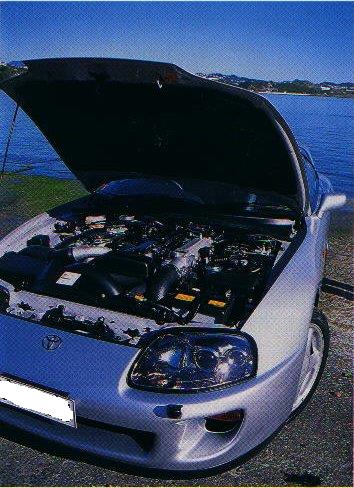
The twin cam, four valve per cylinder engine is based on that which powers the Lexus SC300 and GS300 (cars that are not available in New Zealand) and develops a pretty lusty 320hp (240kw) at 5600rpm and a rip-snorting 315ft lbs torque at 4000rpm. The smaller of the two turbos hits full boost at 2500rpm and when the big one hits home base at 4500rpm, you're on a rocket trip to Mars! Driving the Supra under full acceleration, I was reminded of the filmed coverage of a space-ship takeoff that we see on our television screens. The rockets build up boost and the space craft seems to move slowly off the ground and hover a bit while it builds up energy, then disappear into the sky with incredible fierce acceleration. And thats the way it is with the Supra. Acceleration up to around 4000rpm mark is steady but unspectacular - from that point on the car cuts loose and the acceleration is just awesome. A four speed automatic gearbox is an option, but the car Petch drove had the standard 6 speed manual developed in association with Getrag. The rear axle contained a Torsen limited slip differential. I prefered to drive the Supra quickly with the traction control turned off! You can switch it off manually, but each time you turn off the ignition, the traction control setup is automatically re-instated, and thats exactly the way that it should be. But driving the car quickly through corners, I found that you had to really judge where the secondary power boost comes in, to achieve anything like maximum cornering power. Under these hard cornering conditions, I found the Supra more stimulating to drive with the traction control off, because it is more predictable and conventenial. Similar comments are made about the traction control in the high performance Honda NSX and this is likely to be because traction control alters the driving characteristics of a car away from those which we normally expect. Toyota's engineers charged with developing the Supra into the best-handling front-engined, rear wheel drive car in the world would settle for nothing less then sophisticated, double wishbone suspension at all four corners. 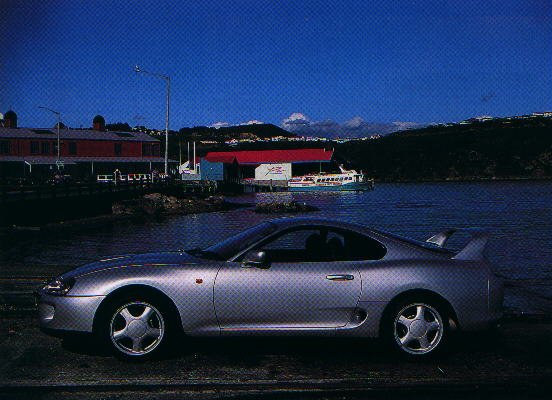
The Supra also follows the trend back towards bigger diameter wheels and has 17 inch alloy wheels, fitted with state of the art rubber in the form of Michelin Pilots. Different sized wheels and tyres are fitted front to rear. Up front the wheels are 8 inches wide and fitted with 235/45 tyres. At the rear they are 9.5 inches wide and carry 255/40 tyres. The result of this brew is phenomenal. The level of grip of the Supra is tremendous. The further I drove the car, the more I was impressed. I hadn't looked at the tyres before leaving Wellington, but I wasn't very far into my journey to Palmerston North, before I stopped to see what sort of tyres were fitted! I just can't say eneough in this brief drive about the outstanding chassis of the Supra, that is enhanced by these tremendous tyres. On a twisting, undulating back country road, just before Palmerston North, I fired the Supra round a bit and found it almost impossible to upset. The level of road holding and grip is among the best I have ever experienced. But this level of road holding does not come at any expense as far as driver and passenger comfort is concerned. The Toyota engineers have apparently found one of the great matches in the automotive industry - outstanding cornering ability allied to high degrees of comfort. 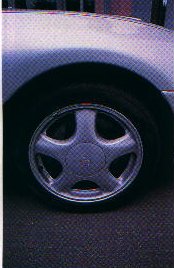
While the tyres and sophisticated suspension design can take much of the credit for the outstanding Supra road performance, the base on which it is built is the remarkably rigid body. This is the platform on which the tremendous Supra chassis dynamics were built. This is an enormously fast car - it is electronically restricted to 156mph and it is possible to reach 150mph in 5th gear, with still another to go. Toyota engineers say if it was left to its own devices, and not electronically hobbled, the Supra would reach 180mph with ease. We report these figures in miles per hour because the pre-release car driven by Mark Petch was fitted with a MPH speedometer. For each and every action, as every shool person knows, there has to be an equal and opposite reaction. And so it is with the Toyota Supra. Such an explosive mixture is controlled by enormous, spiral vented disc brakes, with four pot calipers at the front. At the rear the conventionally vented discs use two pot calipers. Its a combination that works. The brakes on the Supra match the roadholding, and words like sensational come easily to mind as I drifted through the countryside. The Toyota Supra is a large car, well proportioned, and with its huge rear wing simply screams for attention. I can't recall ever having driven a car in New Zealand that has created such a reaction among passers-by. Whenever I stopped the car to buy something, to take photographs I would be approached by people wanting to know what it is, how fast it went, how I found it. It certainly is a traffic stopper. The Supra is built largely of high-tensile steel but the bonnet is fabricated from lightweight aluminium. The result is a car that weighs 1550kg. And the standard of build is excellent. I looked closely at the Supra and the shut lines around the doors, bonnet and boot are all consistent and there was a good quality feel to it. Overseas reviews have commented that the interior of the Supra is almost spartan compared to some of the competition. 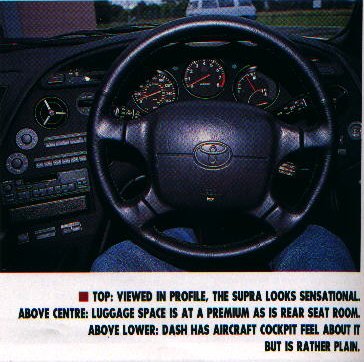
They have tried to impart a feeling of an aircraft cockpit with the Supra. The dash and fascia sweeps up from the central console, across in front of the driver then sweeps down into the drivers door. I found it a bit American and too much like an early Chev Corvette for my liking. One area that did surprise me was just how good the view out of the rear of the car is. With a rear wing that size, you'd think that rearwards vision would be restricted. That's not so. You see quite clearly under it - it's that tall! Forward vision out over that sloping bonnet is quite exceptional while periphal vision is adequate rather than good. 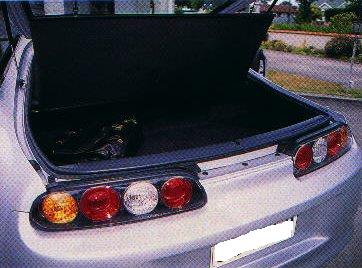
When we tested the previous Supra we were critical of the lack of space in the rear. It was a large car, certainly larger than the Celica, yet the smaller car was much more of a pratical four seater. And those comments can again be directed at the newest Supra. Room in the rear really is marginal. This really is a two seater - I wouldn't like to travel any distance in the back of it. And the same can be said of the amount of luggage room in the boot. Its very small and suitable for small cases and soft bags only. The new Supra has been worth waiting for in terms of stunning looks, shattering top end engine performance and roadholding that simply leapfrogs it ahead of the competition and places it firmly at the head of the class. In terms of sheer all round performance, at first taste the Toyota Supra is simply awesome. Such performance doesn't come cheaply and the price of the Supra is likely to make small players blanch. The cost of progress and the enormous amount of research and development that went into developing this true, front engined, rear-wheel drive Supaercar is reflected in the $165,000 price. Next month we will begin to look more closely at this audaciously fast car along with its kith and kin - the new Celica in both front wheel drive, and turbocharged four wheel drive guises, along with the revised MR2. Sports cars may be a niche market, but Toyota are coming back into the market place with all guns blazing. |
Back to Home Page